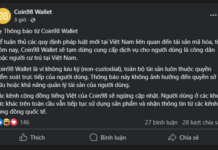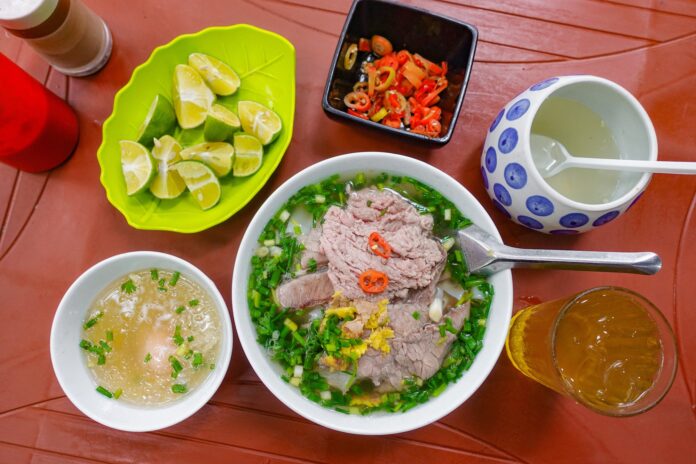In the heart of Hanoi, amidst a myriad of pho restaurants, each boasting its own “secret family recipe,” lies an unassuming eatery that holds its own—Pho Huong Hau. Nestled on a bustling street, this humble establishment has quietly built a reputation that rivals any other.

Recently, when pho from Nam Dinh province was recognized alongside Hanoi’s pho as an intangible cultural heritage in the field of folk knowledge, the unique characteristics and distinctions between the two styles of pho gained prominence. As a result, pho restaurants from Nam Dinh in Hanoi, including Pho Huong Hau, have become sought-after destinations for pho enthusiasts.
Pho Huong Hau: A Legacy of Four Generations
Pho Huong Hau, located at 120 Nguyen Khuyen Street, is a bustling spot that sees a constant flow of locals and tourists alike. It’s not uncommon for passersby to hear phrases like “We’re sold out” or “Sorry, we’re closed” well before the actual closing time.
A Legacy of Four Generations: Pho Huong Hau Thrives in Hanoi
According to Ms. Co Thanh Huong, the current owner and fourth-generation operator of Pho Huong Hau, her family’s legacy with pho spans four generations. Growing up in a family steeped in the tradition of pho making, Huong naturally developed a deep understanding of the craft at a young age. By her early 20s, she had already mastered the art of crafting delicious pho.
Initially, the restaurant had no name, and people referred to it as “Pho Sinh Tu” after the street it was located on. When the street name changed to Nguyen Khuyen, the restaurant remained unnamed for a few years until recently, when it adopted the name “Pho Huong Hau,” a combination of the names of the current owner and her mother.

Ms. Hau, the owner of Pho Huong Hau, has passed on the family legacy to her daughter, Thanh Huong (Photo: Pho Huong Hau)



Pho Huong Hau opens its doors from 6 AM to 12 PM and again from 6 PM to 10 PM. However, locals know that the restaurant often sells out early, and latecomers may have to leave disappointed.
With only a handful of small tables inside and a few plastic tables outside, customers come and go in a steady stream. Ms. Huong shares, “We sell around 500 bowls of pho a day, and on weekends, that number can go up to 600.”




What Sets Pho Huong Hau Apart?
One tell-tale sign of a Nam Dinh-style pho restaurant is the inclusion of dishes like fried rice and stir-fried noodles on the menu. While Pho Huong Hau used to follow this tradition, the current owner, Co Thanh Huong, decided to streamline the menu and focus solely on perfecting their pho to deliver the best possible experience to their customers.

Ms. Huong also shared that she made slight adjustments to cater to the preferences of the majority of Hanoi diners. While Nam Dinh-style pho is typically seasoned with a generous amount of fish sauce, giving it a strong aroma and flavor, Pho Huong Hau reduced the amount used as not all customers appreciate the intense flavor. Additionally, she made subtle tweaks to the broth while ensuring that it maintains its sweet and delicate taste, without compromising on the quality of the beef bones used in its preparation.




Pho Huong Hau proudly retains the distinctive characteristics of Nam Dinh-style pho, particularly in the way they prepare their rare beef. Instead of thinly slicing the meat and adding it to the bowl, the chef pounds the meat on a chopping board until it spreads out thinly without falling apart. It is then mixed with crushed ginger and added to the bowl before being topped with the broth.




Another unique feature of Pho Huong Hau is the use of wider pho noodles, which provide a satisfying chewiness. This is the default option, but for those who prefer thinner noodles, the restaurant also offers that option—just remember to specify when ordering.



The wider pho noodles provide a satisfying chewiness
In addition to the classic pho options like rare steak, well-done flank, brisket, and tendon, Pho Huong Hau also offers a unique dish called “soft beef pho,” available only in the evenings. This dish provides a delightful culinary experience for adventurous diners.
Hanoi to have nearly 100m wide road soon
Hanoi is about to have a nearly 100m wide, 1.3km-long road connecting from Xuân Diệu street to the Tây Hồ villa area.
Hanoi’s Update on the Delayed 1.000 billion VND Hospital Project
To address the challenges faced by investors, the Hanoi People’s Committee has instructed the Long Bien People’s Committee and the Department of Natural Resources and Environment to resolve any obstacles that arise during the implementation of the Thang Long 1,000-Year Oncology and Plastic Surgery Hospital project.
Astonishingly high price for old and dilapidated apartment buildings reaching nearly 200 million VND/m2, rivaling the most luxurious condominiums in Hanoi
Old collective apartments with prices starting from 100 million VND/m2 are usually the first-floor units that can be used for commercial purposes, while the upper-floor units are priced at 60-80 million VND/m2 for residential purposes.











































